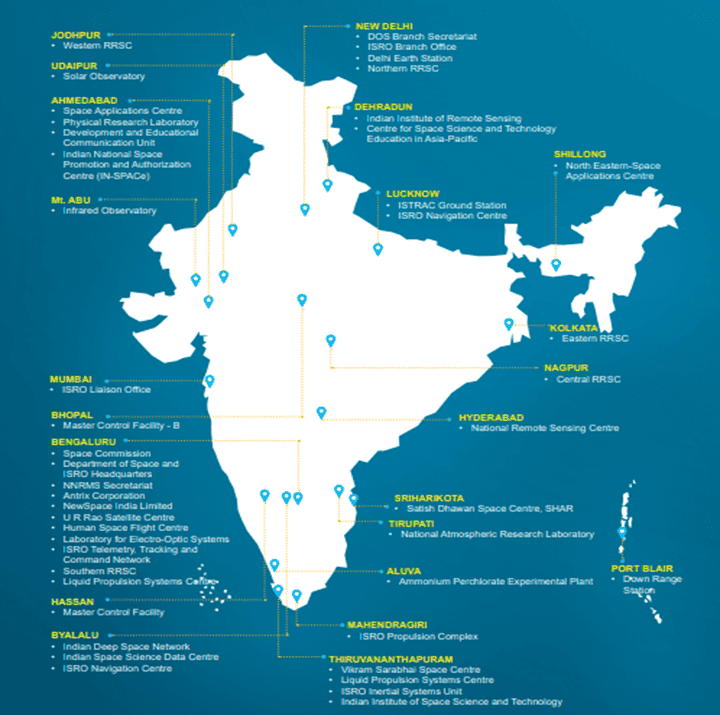
India has one of the world’s most economical space programmes. India’s accomplishments in launching lunar missions, building satellites, transporting foreign satellites, and even landing on Mars have brought international prominence to the country.
At present, the estimated worth of the space economy worldwide is US$ 360 billion. With an anti-satellite weapon, India became the fourth country to join the exclusive space power club. The country makes up 2% of the world’s space industry, despite becoming one of the few spacefaring countries.
With a remarkable success record, ISRO stands as the sixth most prominent space organisation globally. The sector is not, however, limited to space programmes funded by the government. One of the most dynamic industries right now is private space exploration.
With that being said, let’s take a closer look at the space sector in India, its growth over the years, and what the future holds for the industry. Let’s get started.
Understanding the Indian space industry
The whole spectrum of operations and resources that provide value and benefit to humankind as they explore, research, understand, oversee, and employ space is known as the space industry.
The expansion and significant change in the space sector, as well as the increasing integration of space into the economy and society, all contribute to the growth and evolution of the space economy.
Below is an illustration of the total space centres across India.

Source: IBEF
General information about the sector:
Satellite manufacturing: Governmental and commercial organisations work together to manufacture components of satellites and their launchers; the PSLV-C53 space launcher results from the first-ever formal public-private partnership in India.
Satellite launches: India has been known worldwide as a supplier of reliable and reasonably priced space solutions because of the several notable achievements made by the Indian Space Programme, which ISRO manages.
Services for satellite launch: ISRO offers launch facilities to international and commercial organisations. The Polar Satellite Launch Vehicle (PSLV) and the Geosynchronous Satellite Launch Vehicle (GSLV) are the two launchers that India currently uses.
As ISRO’s commercial division, NewSpace India Limited (NSIL) was founded to draw private sector demand for space-related technologies via aggregator economy models and technology transfer.
Satellite applications: Data processing, testing, disaster prevention, earth observation, remote sensing, and space-based navigation are all part of the satellite applications. Private space companies are also ready to capitalise on the potential of the space economy, along with ISRO.
The Indian Space Research Organisation (ISRO) is the primary driving force behind India’s space industry.
The goal of the Indian Space Programme is to incorporate space technology to promote the country’s growth. Satellite communication, satellite navigation, and other developing fields are among the primary focus domains of the space programme.
The main objective is to set up operational space services independently in these areas and conduct ongoing research and development in them.
Also read: Looking into India’s aviation industry: A sky full of possibilities
Growth and evolution of the Indian space sector
The Indian Space Research Organisation (ISRO) was founded in 1969 and successfully launched Aryabhata, the country’s first satellite, in 1975.
Notably, the first space university in Asia, the Indian Institute of Space Science and Technology (IIST), was founded in 2007 to provide top-notch space science and technology training that meets the needs of the Indian Space Programme.
ISRO has since shown India’s competence in space technology by launching many spectacular missions, like the Mars Orbiter Mission and the Chandrayaan mission to the Moon.
At present, the space sector in India is estimated to be worth $9.6 billion, accounting for 2% of the worldwide space economy. The government spends almost $2 billion on space exploration, while since 1999, it has sent out 381 foreign satellites for 34 countries, earning $279 million in revenue.
The recent launch of Chandrayaan-3 took place on July 14 by the Indian Space Research Organisation, the sixth-largest national space agency globally. As a follow-up to Chandrayaan-2, this mission aims to show that it can safely land and explore the lunar surface from start to finish.
While India’s space sector has been expanding at a rate of 4% per year in recent years, researchers predict that the worldwide space market will reach $1 trillion by 2040.
Since 2021, Indian space startups have gotten over $200 million in financing, and the company said that there may be more private sector investments ahead, given ISRO’s ambition to establish its space station by 2030.
Also read: Chandrayaan-3: India’s moonshot to space economy stardom
Future outlook of the space industry in India
By 2030, the Indian government wants its space industry to represent 9% of the world market. By 2040, India may account for a $100 billion addressable market or a much more significant portion of the global space economy.
In addition, India hopes to secure a more significant portion of the world economy by about 10% by 2030. The sector is predicted to reach $13 billion in size by 2025.
India’s space tech startup ecosystem, including satellite applications, ground equipment, and launch vehicles, is driving this growth. Other factors behind the growth of this sector are the country’s investments in space stations, human lunar missions, and defence applications.
India’s affordability and defined capacity in satellite/launch vehicle manufacturing make it an appealing option for foreign satellite operations.
The country must employ comprehensive regulations for all areas of space, encourage foreign investments in satellite establishments, and use programmes like production-linked incentives (PLI) to promote India as the centre for satellite manufacturing.
Top space stocks in India to invest in
Below are the top stocks in the aerospace sector in India on BSE, ranked by market capitalisation (as of December 19, 2023).
| Company | Share price return (1Y) as of December 19, 2023 | Market cap (₹ cr.) | Net profit (₹ cr.) |
| Hindustan Aeronautics | 110.82% | 187,073.09 | 5,811.17 |
| Bharat Electronics | 72.52% | 126,349.53 | 3,006.67 |
| Data Patterns | 60.1% | 11,256.14 | 124.00 |
| MTAR Technologies | 41.46% | 7,160.99 | 104.08 |
| Apollo Micro Systems | 334.55% | 3,338.89 | 19.07 |
Also read: Azad Engineering IPO: What you need to know before applying
Conclusion
By offering creative ideas to the space industry, startups are becoming increasingly significant parts of the Indian space ecosystem. With many large-scale projects and efforts underway, the Indian space industry seems to have a bright future.
India will undoubtedly have a lasting impact on space exploration and technology with sustained government funding and involvement from the commercial sector.

